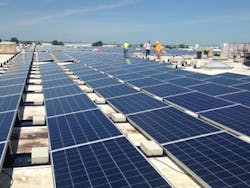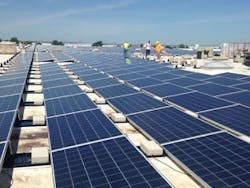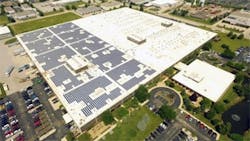Alternative energy: Solar-powered energy savings lead to a bright future
The world looks, feels different from a rooftop. Standing upon Magid Glove and Safety’s three-story building in the Chicago suburb of Romeoville, IL, it is sky, crowns of trees, water towers, and the expanse of a 600,000-square-foot roof – like several bright white football fields. It is quiet except for a breeze and the sound of workers securing solar panels – the drilling of screws to frames, rolling hand carts, and music coming from a cordless jobsite radio.
“On the roof, it’s peaceful as can be,” Carole King and Gerry Goffin wrote. “I’ll go up where the air is fresh and sweet…” What’s sweet is this roof will offset 100% of the company’s electrical use. That is just the beginning. With the largest rooftop solar installation in the Midwest, Magid is helping to change the world down here.
Going solar, starting with a Google search
Magid’s journey to solar was not a straight one. In fact, Harvey Cohen, Magid’s president and the third generation of this 72-year-old, fourth-generation family-owned business, hopes the company’s experience will provide guideposts for others.
“We didn’t know who we could talk to,” says Cohen, “so I started by doing Google searches. You don’t really learn until you get into the mix.”
In 2013, Magid relocated from Chicago to Romeoville, and during roof renovations one year after the move, Cohen began to explore the solar option. “We decided we should look into solar to learn if it was viable,” Cohen explains. “In anticipation of possibly doing solar, we spent an additional $400,000 on a roof with a thicker rubber membrane for support and went from 2 inches to 6 inches of insulation to conserve energy.” At the same time Cohen was doing his research, the price of solar panels was dropping rapidly. Combined with tax incentives as well as utility rebates, Cohen says, “In my preliminary costing, the financials looked rosy.”
Cohen and Magid laid out an investment of $5.5 million for their 3.5 MW solar array with a payback period conservatively estimated at about four years.
Here’s how they arrived at their numbers:
- Close to $2 million in federal solar tax credits (30%), also known as Investment Tax Credits or ITCs. This 30% is deducted from taxes owed when a company files its annual federal tax return.
- $800,000 from Magid’s Illinois Solar Energy Certificates (SRECs)
- $800,000 in rebates from Commonwealth Edison Company (www.comed.com), a subsidiary of Exelon Corp. ComEd provides electric service in northern Illinois to about 70% of the state’s population.
Continental addressed the interconnection agreement with ComEd and what was needed for the rebates, and Convergence Energy handled the calculations required for the federal tax credits and the SRECs.
Brian Haug, director of energy solutions for Continental, comments: “It was great for all of us to work with a very educated client. In fact, Harvey bought all the SRECs himself before we even started!”
For those in Illinois who are planning to or thinking of making this move: Currently there are many connection applications to both of the larger Illinois utilities, ComEd and Ameren, and the queue for finalizing agreements is getting steadily longer.
Along the way, Cohen found the required expertise in Continental Electrical Construction Co., another fourth-generation family-owned company in Chicagoland that designed, engineered, installed, and will maintain Magid’s solar plant with its IBEW-trained and certified team. Continental brought in Convergence Energy to assist with financial calculations to create optimal legal, tax, and accounting outcomes.
Continental is known for other large renewable energy projects, including at ABT in Glenview, IL, with a 516 kW solar array and a 1000 kwh Tesla battery, and at North Central College in Naperville, IL, with a 538 kW solar array as well as battery storage of 500 kwh. Continental is now working with Illinois manufacturers in various stages of decision making on installing solar and storage.
Magid employees are avidly watching the progress of the installation on an internal website. After an Oct. 1 ribbon-cutting for the array, a flat panel in the lobby will allow for viewing the array dashboard and seeing real-time metrics for energy, weather conditions, and environmental benefits.
Financials: "...really not a gamble"
Any investment decision is a tradeoff. In reviewing the addition of renewable energy generation, a company must compare the benefits with, for example, developing a new product line or adding new plant equipment. What stands out in Magid’s case is the 100% of electrical use offset during daylight hours. This eliminated an operation cost of $40,000 per month. Says Cohen: “This is really not a gamble.”
While the primary cost of a solar array and battery storage (in their initial purchase and construction) is a top concern for any company considering investing in solar, it’s important to note, too, that when the system is up and running, maintenance and operating costs generally are low. In addition, companies may find current financial incentives compelling enough to jump in with a solar investment.
Energy storage as a revenue source?
For next year, Magid is considering adding 2 Mwh of energy storage to create its own microgrid. The cost of a lithium ion battery would be $3 million, with an estimated four to six years payback for storage. The move would help ensure continuous power, even if there’s an outage on the grid. The battery storage should supply cash revenue from wholesale markets, help Magid save on energy bills, reduce demand charges (also called capacity charges), and provide faster and other more reliable backup than standard generators. This reliability is a key factor for Magid.
With energy storage, the owner receives a revenue stream from frequency regulation on the grid. Frequency regulation or control is a collection of actions meant to maintain the grid’s frequency where it needs to be – at 60 cycles per second or 60 hertz (Hz). If the energy generated is greater or less than demand, it throws off the frequency. Batteries can decrease or increase their output in seconds and stabilize the frequency, thereby relieving stress on the grid.
“We’re seeing growing interest from our members in solar and battery storage for their plants,” states Kent Gladish, vice president of member development for the Schaumburg, IL-based Technology and Manufacturing Association. “In a recent operations peer group, we discussed the opportunities for small to medium-sized manufacturers, and we will continue to explore the technology and options available.”
“It was like building the pyramids,” Cohen jokes about the 10,500 solar panels on 440 skids that arrived in 13 large semi-trailer truckloads. It required careful logistics not to disrupt normal operations, with the first directive that only two trucks were allowed to unload per day.
At the end of one week, all 440 skids were stacked in an empty warehouse area on the ground level ready for the next step – bringing the skids to the roof. It took four weeks for the crane to lift all the panels to the roof. From there, the boxes of panels were moved into place by hand trucks, as forklifts were too heavy and would have created ruts in the insulation. One team member pulled and three pushed. The fixed panels were locked into place and weighted down but not attached to the roof. To avoid leaks, the panels cannot create holes in the roof.
The layout for the panels ensures that the air conditioning units, machinery penthouses, and vents do not shade any part of the array. This installation is called a “ballasted solar array” as it is weighted down with cement blocks. It is guaranteed up to 125 mph. (Stronger winds can create problems.) One panel is approximately 75 pounds, all weighted. Steel sheaths close off the higher end of the panels to prevent the wind from whipping up a panel.
In the process of unloading and unpacking panels, Magid created a recycling system for all the discarded packaging through its weekly recycling program.
To ensure that Magid receives the full extent of its 25-year warranty on the array, Magid’s energy team, along with Continental, will perform ongoing and annual maintenance.
Deanna Nord, owner of Nord Strategy Group, is a writer, public speaker, and creative strategist. Contact her at [email protected].
For continuous maintenance, a DC optimizer (a DC/DC converter) is connected to each solar module. The optimizer increases the energy output of the systems by constantly tracking the maximum power point (MPPT) of each module. In the event of a malfunction in module 1503, for example, an alert will direct the energy team to that module. The optimizers continually watch the performance of each module and communicate performance data to the monitoring platform for viewing on any computer, laptop, or smartphone.
Time-based maintenance is annual and minimal. Brian Haug, director of energy solutions for Continental, recommends cleaning off soil, bird droppings, and other debris once a year. That being said, rain helps wash away some dirt, and because the panels heat when they produce electricity, snow melts right off. Maintenance team members also do spot checks to make sure the connections are tight, that there is no shading on any module, and that no wires touch the roof. In addition, standard OEM procedures are performed to ensure the system produces the way it should and lives up to its warranty.
One final point on the quality of the power from the solar array: It is the same quality as that provided by the grid, so no extra filtering is required for Magid’s lighting and motors. The only need Magid has for “perfect power” is in its data center.



